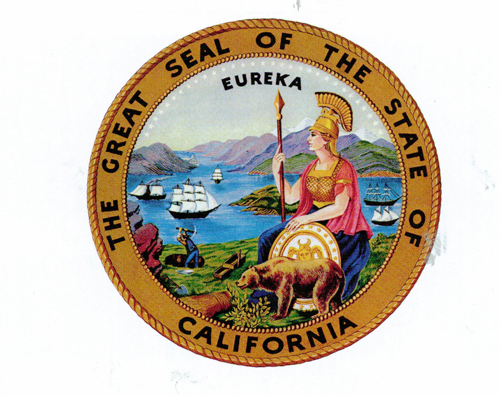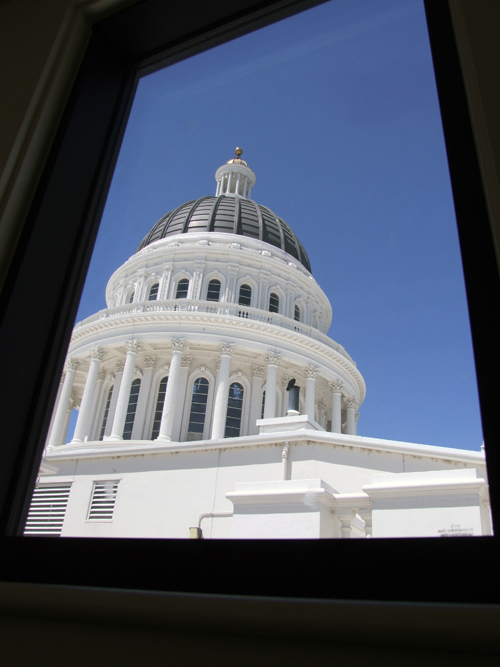
By Donald H. Harrison
SACRAMENTO—I had worked in the building as a news reporter during the 1960s and 1970s, spanning the gubernatorial administrations of Ronald Reagan and Jerry Brown. Shuttling from hearings to news conferences to floor debates, and then back to my desk at the Associated Press, and later at the Capitol bureau of the San Diego Union, I had seen the tourists and the tour guides, but never followed in their footsteps. But recently, more than 30 years later, with Brown coincidentally back in the governor’s office, Nancy and I escorted our grandson, Shor, on a quick visit to the Capitol.
The Legislature then being in recess, Kevin Powers, a legislative aide to Assemblyman Marty Block (D-San Diego), had the time to take us through the famous building. An admirer of the legislative process who is himself involved in helping to research legislation that affects state-funded higher education, Powers mixed some of the information one can find on-line or in tour books with his perspective as a legislative staff member.
For example, when we paused outside an entrance to the Assembly chamber – an entrance used both by legislators and their staff members who bring bills and amendments to the clerks – Powers confided that the sergeants-at-arms there are under orders to require men to wear ties and jackets on the floor while the Assembly is in session. “That is unbending,” said Powers, who, like myself, was then dressed in far more casual summer clothes. The Assembly was out of session but nevertheless, we trooped up to the Gallery to look out over the 80-member chamber, where the drapes and walls are green.
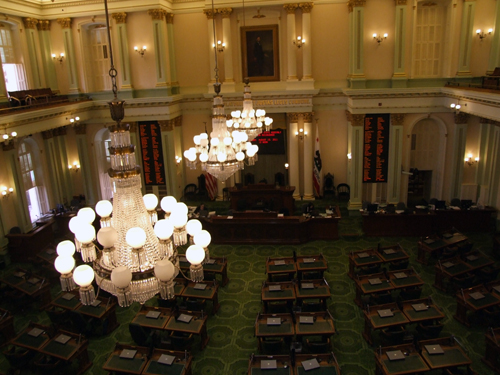
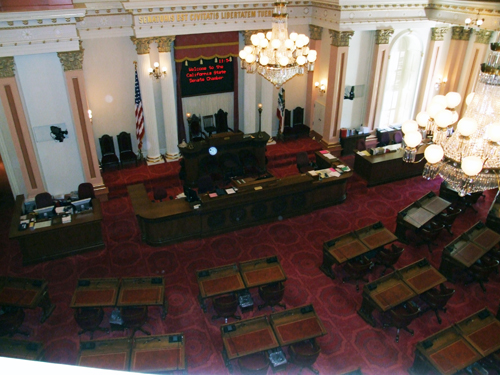
Powers explained that the Assembly mimics the color scheme of Great Britain’s House of Commons – the popularly elected body—whereas the red carpeted and draped California Senate is inspired by the House of Lords, which was a body appointed by the crown. Although California’s 40-member Senate has always been elected (with half as many members as the Assembly), it has prided itself on being the more “deliberative” of the two bodies. This is symbolized by the manner in which members of the two Houses vote. Assembly members do it electronically; the clerk “opens the roll,” and you hear pings as lights on tally boards in front of the chambers are switched on by members at their desks — a green light for “yes” and red for “nay.” The computer simultaneously counts the votes, and within a few seconds, the outcome is known.
In the Senate, on the other hand, the clerk laboriously calls the roll in alphabetical order, with members answering “aye” or “nay” to their names, and the clerk repeating their vote, to make certain he or she heard it correctly.
In such a context, some say that the green and red color schemes of the two chambers are reminiscent of traffic lights – it’s green for “go” in the Assembly, red for “stop” in the Senate. One has the impression that over the years, the Assembly has approved far more bills than the Senate, or put another way, more legislation has been killed in the Senate than in the Assembly. This results not only from a tendency for the Senate to be more conservative in its political outlook, but also from the sheer press of time. Some bills die at the end of the session, simply because they never got to be debated on the floor.
Relocated from my days covering the Legislature were the media desks, which used to run along the side walls of the two chambers. In the Sacramento bureau of the Associated Press, I had been primarily responsible for covering the state Senate, and my desk along the wall was adjacent to the appropriately much larger desk of State Senator Mervyn Dymally (D-Los Angeles), who would go on to become lieutenant governor and later a congressman. Often Dymally would lean over to me to explain one legislative maneuver or another.
Over both chambers hang large portraits of a U.S. President – George Washington in the Senate, and Abraham Lincoln in the Assembly. The Washington portrait is said to be a copy of one done by the artist Gilbert Stuart—in this case supposedly copied by Stuart’s own daughter, Jane. Presented to the state Senate in 1854, the painting reportedly is the Capitol’s oldest artifact. The Lincoln portrait by artist William Cogswell dates only to 1909. Prior to that the visage of John Sutter – near whose mill, gold was first discovered — looked out over the Assembly’s deliberations.
Neither Washington nor Lincoln ever set foot in California; the first U.S. President known to have that distinction was Ulysses S. Grant, who was stationed in the state while working his way up the ranks of the U.S. Army.
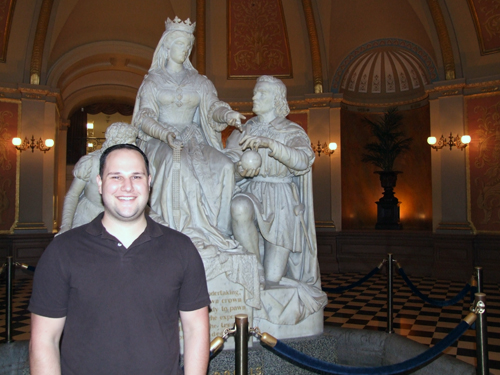
In the Capitol rotunda, a large statue of Queen Isabella examining a globe held out to her by Christopher Columbus also focuses on other historic figures who never visited California. However, those who consider the large sculpture dominating the first floor of the rotunda appropriate for the state, say it was Columbus’s voyage west, in the hope that he would reach India and China in the east, that set the stage for European explorers eventually venturing to California. It was 50 years after Columbus’s 1492 voyage that Juan Rodriguez Cabrillo sailed in 1542 into the harbor that is now named for San Diego (although he named it “San Miguel”) and claimed the area for Spain.
There is quite a bit of interesting art hanging in the Capitol. I found myself fascinated by the contrasting portraits of Governor Jerry Brown and Governor Pete Wilson, who in 1982 ran against each other for the U.S. Senate, with Wilson, a former mayor of San Diego, being the victor. Democrat Brown’s portrait was semi-abstract—as some said his political philosophy was in those days – whereas Wilson’s portrait outdoors was more traditional, with the Capitol dome seen over his shoulder.
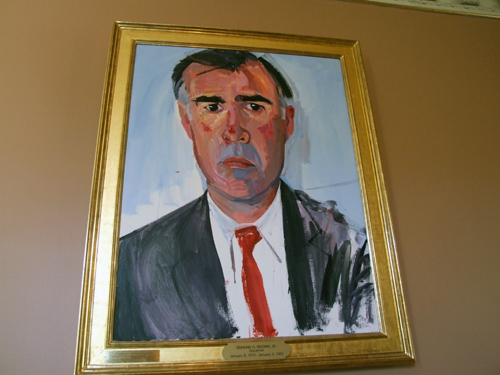
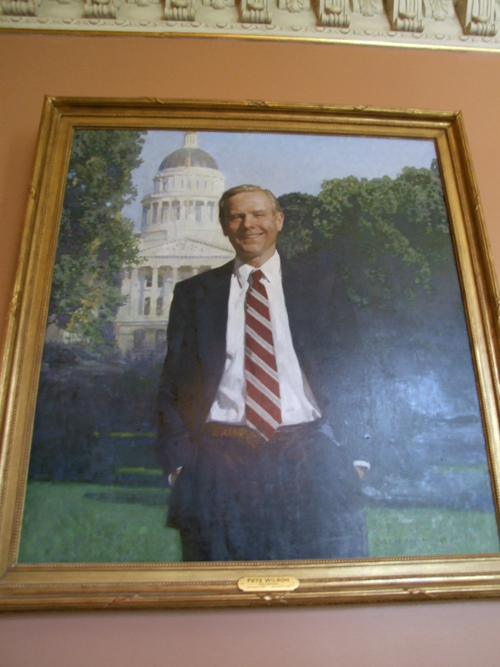
Former Gov. Arnold Schwarzenegger’s portrait hasn’t been placed on exhibit in the Capitol yet; Powers speculating that state budget cuts – and not the recent, divorce-prompting controversy over the former actor fathering a child with his housekeeper –are the reason for the delay. Meanwhile, one wonders whether Brown will have a new portrait done for this administration, so that future tourists can see him as both a young man and the older man he is today.
As Grover Cleveland was both the 22nd and 24th President of the United States, because of non-consecutive terms, so too does history now record Brown as the 34th and 39th governor of California. To add to the confusion, Brown’s father, Edmund G. Brown, was the 32nd governor. The man who occupied that office between father and son – Ronald Reagan – was the only California governor ever to become U.S. President. However, the 30th governor of California, Earl Warren, became Chief Justice of the U.S. Supreme Court, having been appointed by President Dwight D. Eisenhower.
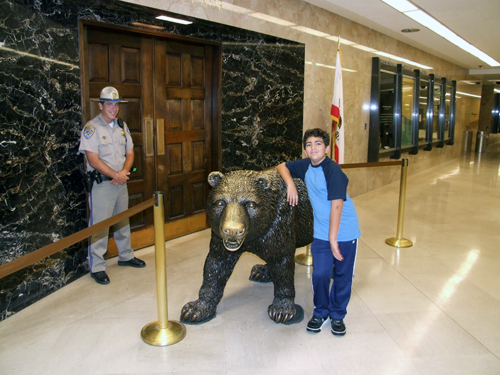
In a hallway of the Capitol, courtesy of Schwarzenegger, stands a statue of a California grizzly bear which has been affectionately nicknamed “Mike” by the press corps. Why Mike? It stands in the hallway just outside the doorway to the gubernatorial office suite, and reporters like to set up their microphones on the bear’s back – so they can record the governor’s words as he emerges.
Upstairs, facing each other in a corridor, are photographs of all the members of the state Senate and the state Assembly. Powers said this is one of the first times since he’s been at the Capitol that a photograph fills all 120 spaces—there being no legislative vacancies at the moment in either of the two houses.
The portraits are exhibited according to the district number the legislator represents. Given that San Diego districts have the highest numbers, you can see members of the San Diego delegation at a glance at the right hand bottom corner of either board. It struck me how many members of the San Diego delegation got their starts as San Diego City Council members. On the State Senate board one finds the photos of Christine Kehoe and Juan Vargas, both City Council alumni. On the Assembly board are Toni Atkins and Ben Hueso, also former council members. Clearly the San Diego City Council is a good political stepping stone.
While I took interest in the legislators’ portraits, Shor was more interested in the official seals of the State of California, the Senate and the Assembly. Having studied some Greek (and Roman) mythology, he was fascinated that on the Great Seal of California is Athena (Minerva), who was considered by the ancient world as the goddess of wisdom. The seal is meant to draw an analogy between Athena, who was born full grown from the head of Zeus (Jupiter), and California, which after the gold rush became a full-blown state without having to go through the long territorial process that other states did. On the seal, Athena sits on a knoll with a California grizzly bear at her feet. She looks over a bay filled with sailing ships, as a gold prospector wields a pick. “Eureka” says the seal under 31 stars, meaning “I have found it.” California is the 31st state in the Union. A faint replica of this seal can be seen on California driver’s licenses.
The State Senate seal features a quill pen over a parchment on which is written in Latin the word “Legis.” It was designed in 1967 as the result of a contest sponsored by State Sen. Jack Schrade (R-San Diego) for artists in the state. The winner was Linda Taylor, a student at Sacramento State College
The sponsor of the Assembly Seal was Assemblyman Leo J. Ryan (D-San Mateo) who years later would meet a tragic death in Guyana. That seal has such symbols as the California Grizzly, the Golden Poppy (which is the state flower), a palm tree to represent Southern California and snow-capped mountains to represent Northern California. In Latin, the seal advises that “It is the duty of Legislators to make just laws.”
The Capitol is not only where California’s state government conducts business, the buildings and grounds also comprise a well-curated museum well worth the visit—whatever your political views.
*
Harrison is editor of San Diego Jewish World. He may be contacted at donald.harrison@sdjewishworld.com
File: US Canada West 24
